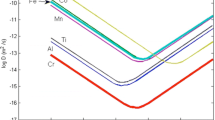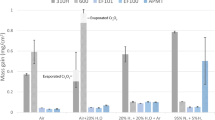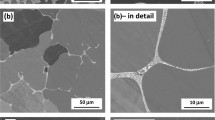Abstract
The oxidation behavior of Fe-14Cr-14Ni (wt.%) and of the same alloy with additions of 1 and 4% silicon was studied in air over the range of 900-1100° C. The presence of silicon completely changed the nature of the oxide scale formed during oxidation. The base alloy (no silicon) formed a thick outer scale of all three iron oxides and an internally oxidized zone of (Fe,Cr,Ni) spinels. The alloy containing 4% silicon formed an outer layer of Cr2O3 and an inner layer of either (or possibly both) SiO2 and Fe2SiO4. The formation of the iron oxides was completely suppressed. The oxidation rate of the 4% silicon alloy was about 200 times less than that of the base alloy, whereas the 1% silicon alloy exhibited a rate intermediate to the other two alloys. The actual ratio of the oxidation rates may be less than 200 due to possible weight losses by the oxidation of Cr2O3 to the gaseous phase CrO3. The lower oxidation rate of the 4% silicon alloy was attributed to the suppression of iron-oxide formation and the presence of Cr2O3, which is a much more protective scale.
Similar content being viewed by others
References
J. A. Mathews,J. Ind. Eng. Chem. 21, 1158 (1929).
J. W. Hickman and E. A. Gulbransen,Trans. Am. Inst. Min. Metall. Pet. Eng. 180, 519 (1949).
E. A. Gulbransen and W. R. McMillan,J. Ind. Eng. Chem. 45, 1734 (1953).
E. A. Gulbransen and K. F. Andrew,J. Electrochem. Soc. 106, 941 (1959).
M. Sugiyama and T. Nakayama,Jpn. Inst. Met. J. 24, 541 (1960).
D. L. Douglass and J. S. Armijo,Oxid. Met. 2, 207 (1970).
G. C. Wood, J. A. Richardson, M. G. Hobby, and J. Boustead,Corros. Sci. 9, 659 (1969).
J. S. Armijo,Corrosion (Houston) 24, 24 (1968).
A. Kumar, M. Nasrallah, and D. L. Douglass,Oxid. Met. 8, 227 (1974).
K. Hauffee,Metalloberflaeche (A) 8, 97 (1954).
V. I. Arkharov, V. N. Bogoslovskii, and A. I. Yarosheva,Prot. Met. (USSR) 322 (March 1975).
L. Himmel, R. F. Mehl, and C. E. Birchenall,J. Met. 5, 827 (1953).
E. Scheu and K. Kiwit,Arch. Eisenhuettenwes. 9, 405 (1936).
C. S. Tedmon, Jr.,J. Electrochem. Soc. 113, 766 (1966).
J. E. Croll and G. R. Wallwork,Oxid. Met. 1, 55 (1969).
Author information
Authors and Affiliations
Rights and permissions
About this article
Cite this article
Kumar, A., Douglass, D.L. Modification of the oxidation behavior of high-purity austenitic Fe-14Cr-14Ni by the addition of silicon. Oxid Met 10, 1–22 (1976). https://doi.org/10.1007/BF00611695
Received:
Issue Date:
DOI: https://doi.org/10.1007/BF00611695




